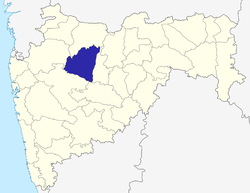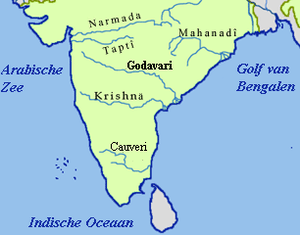Jayakwadi Dam
| Jayakwadi Dam Marathi: जायकवाडी धरण | |
|---|---|
 | |
 | |
| Official name | Jayakwadi-I D02995 |
| Location |
Jayakwadi, Maharashtra India |
| Coordinates | 19°29′8.7″N 75°22′12″E / 19.485750°N 75.37000°ECoordinates: 19°29′8.7″N 75°22′12″E / 19.485750°N 75.37000°E |
| Construction began | 1965 |
| Opening date | 1976[1] |
| Construction cost | 4,700 cr [2] |
| Owner(s) | Government of Maharashtra |
| Dam and spillways | |
| Type of dam | Earthen dam |
| Impounds | Godavari River |
| Height | 41.30 m (135 ft) |
| Length | 9,998 m (32,802 ft) |
| Reservoir | |
| Creates | Nath Sagar Jalashay (Marathi: नाथसागर जलाशय) |
| Total capacity | 2.909 km3 (1.027×1011 cu ft) |
| Catchment area | 21,750 km2 (8,398 sq mi) |
| Surface area | 350 km2 (135 sq mi) |
| Power station | |
| Installed capacity | 12 MW |
The Jayakwadi project is one of the largest irrigation projects in the Indian state of Maharashtra. It is a multipurpose project. The water is mainly used to irrigate agricultural land in the drought-prone Marathwada region of the state. It also provides water for drinking and industrial usage to nearby towns and villages and to the municipalities and industrial areas of Aurangabad and Jalna district. The surrounding area of the dam has a garden and a bird sanctuary.
Location
It is located on Godavari river at the site of Jayakwadi village in Paithan taluka of Aurangabad district in Maharashtra State state of India.
History and significance
A plan to build a dam on Godavari river in the drought-prone Marathwada region was first conceived during rule of state of Hyderabad. The plan was to build a dam in Beed district near village Jaikwadi (जायकवाडी) with storage capacity of 2,147 MCM (million cubic metres).[3] The project came to know as Jayakwadi project after name of the village. However, after formation of new state of Maharashtra and comparative analysis on alternative places, it was decided to build a dam 100 km upstream at Paithan. The project was continued to name as Jayakwadi even after it was shifted to a new location. Building dam at higher level made it possible to have longer canals and thus providing irrigation facility to a larger region. The project proposal for this was completed by 1964.Although It was not natural Point Due to this Catchment area spread horizontally and Unnecessarily More people had shifted from their natives and well settled lives.
The foundation of the dam was laid by the then Prime minister of India Lal Bahadur Shastri on 18 October 1965. The dam was inaugurated on 24 February 1976 by the then Prime minister Indira Gandhi.[3] The chief engineer of this project was Mr. A.A.A. Siddiqui.
Dam
Jayakwadi is one of the largest earthern dams in Asia. Its height is approx 41.30 m and length of 9,998 m (10 km approx) with total storage capacity 2,909 MCM (million cubic meters) and effective live storage capacity is 2,171 MCM. The total catchment area of dam is 21,750 km2. There are total 27 water gates for the dam.
In the year 2009 it has entered in 35th year of its life. It has in its lifetime overflowed only 17 times. On 10 August 2006 highest discharge of 250000 ft3/s was recorded.in India of maharastra state district Aurangabad.
Nath Sagar Jalashay
Nath Sagar Jalashay is the name of the reservoir formed by Jayakwadi Dam. Fed by the Godavari and Pravara rivers the reservoir is about 55 km long and 27 km wide and spans over 350 km2. Total submergence area due to the reservoir is approx 36,000 hectares.[4]
Unfortunately siltation has taken a heavy toll on the project. It is estimated that approximately 30% of the dam is filled with silt, reducing its life as well as storage capacity. Survey findings show that from 2003 to 2012, there was a loss of 31% (that is 8.08 thousand million cubic (TMC) feet) in dead storage and 14% (that is 10.73 TMC) in live storage capacity of the dam due to silt.[4]
Purpose
Jayakwadi project is a multipurpose project. The main purpose was to irrigate land for agriculture in the drought prone Marathwada region of Maharashtra state. Other important purpose was to provide water for drinking and industrial usage to nearby towns and villages and to the municipalities and industrial areas of Aurangabad and Jalna. The 80% of water of dam is meant for irrigation, 5-7% for drinking water and the rest for industrial purposes.[5] The average daily discharge of the dam is around 1.36 MCM, out of which 0.05 MCM of water is supplied to the MIDC area, 0.15 MCM is distributed to fulfil the needs of Aurangabad city, while the remaining amount is lost in evaporation.[6]
Irrigation
Jayakwadi project is one of the largest irrigation projects in Maharashtra. Jayakwadi Dam irrigates cultivable area of 237,452 hectares in the districts of Aurangabad, Jalna, Beed, Ahmednagar and Parbhani through its left and right canals. The length of left bank canal is 208 km & the length of right bank canal is 132 km. The total command area is 183,858 hectares. The gross irrigated area by 96,000 hectares under right bank canal was further enlarged by constructing Majalgaon Dam which acts as a balancing reservoir in addition to harness the Sindphana tributary of the Godavari river.
Electricity generation
Jayakwadi Dam houses a hydroelectric power plant with installed power generating capacity of 12 MW. The water used for power generation is pumped back to main reservoir using a pump house.
The dam is also a primary source of water to the Parli Thermal Power Station.[7]
Industrial use
Around 0.05 MCM water is supplied daily from dam to various industries located in Aurangabad and Jalna MIDC areas.
Flora and fauna
Aquatic vegetation has species of Chara, Spirogyra, Hydrilla, Potamogeton and Vallisneria. Surrounding areas grow Argemone mexicana and Ipomoea carnea. Around 37 species of flora have been reported in the vicinity of reservoir. Seasonal farming (gal pera) is carried out on the exposed land when the waterline recedes.[2]
Dnyaneshwar Udyan
Dnyaneshwar Udyan is one of the largest gardens in Maharashtra resembling the Brindavan Gardens of Mysore. It is spread over 125 hectares and is situated on the banks of Nathsagar Lake formed due to Jayakwadi Dam. It is located near the town of Paithan which is 50 km south of Aurangabad.
Jayakwadi Bird Sanctuary

The Nath Sagar reservoir creates 30 island of various sizes in the shallow waters, with trees for roosting, this provides an ideal shelter for migratory birds. Close to the dam a bird sanctuary has been created which is home for many species of resident and migrant birds. Almost 200 species of birds can be found in this region, which includes more than 70 species of migratory birds. Out of these, 45 chief species are of international migration. Notable amongst migratory birds are cranes, flamingos, pintails, wigeons, shovellers, brahminy ducks, pochards, teals, godwits, shauces and glossy ibises.[8]
Many species are reported in numbers larger than 1% of their bio-geographic population thresholds in Jayakwadi bird sanctuary (Wetlands International Norms – 2002). The Jayakwadi bird sanctuary qualifies for the congregatory criteria A4-i, A4-iii and A4-iv. [ A4i (≥1% biogeographic population), A4iii (≥20,000 water birds), A4iv (known to exceed thresholds set for migratory species) ].[2]
See also
References
- ↑ "Jayakwadi-I D02995". Retrieved 1 March 2013.
- 1 2 3 "Jaikwadi Dam and Its Nath Sagar Reservoir". authorstream.com. Retrieved 13 September 2013.
- 1 2 Gadre V. R. "जायकवाडी प्रकल्प". Mumbai: महाराष्ट्र राज्य मराठी विश्वकोश निर्मिती मंडळ. Retrieved 11 July 2013.
- 1 2 "Evaporation rate up in Jayakwadi dam". Times of India. India. 4 April 2013. Retrieved 8 July 2013.
- ↑ "Near their largest dam lie the driest villages". Hindustan Times. India. 21 August 2012. Retrieved 22 September 2012.
- ↑ "More rains lead to rise in Jayakwadi water levels". Times of India. India. 27 June 2013. Retrieved 8 July 2013.
- ↑ Khapre, Shubhangi (12 February 2013). "Power generation drops by 1,000 MW". Mumbai: Indian Express. Retrieved 1 March 2013.
- ↑ "Jayakwadi Bird Sanctuary". Hoparoundindia.com. Retrieved 8 May 2013.
External links
| Wikimedia Commons has media related to Jayakwadi Dam. |



